|
|
|
Those known to have served at RAF Biggin Hill during the Second World War 1939-1945. The names on this list have been submitted by relatives, friends, neighbours and others who wish to remember them, if you have any names to add or any recollections or photos of those listed,
please
Add a Name to this List
|
|
|
The Wartime Memories Project is the original WW1 and WW2 commemoration website.
Announcements

- 1st of September 2024 marks 25 years since the launch of the Wartime Memories Project. Thanks to everyone who has supported us over this time.
- The Wartime Memories Project has been running for 25 years. If you would like to support us, a donation, no matter how small, would be much appreciated, annually we need to raise enough funds to pay for our web hosting and admin or this site will vanish from the web.
- 19th Nov 2024 - Please note we currently have a huge backlog of submitted material, our volunteers are working through this as quickly as possible and all names, stories and photos will be added to the site. If you have already submitted a story to the site and your UID reference number is higher than
264989 your information is still in the queue, please do not resubmit, we are working through them as quickly as possible.
- Looking for help with Family History Research?
Please read our Family History FAQs
- The free to access section of The Wartime Memories Project website is run by volunteers and funded by donations from our visitors. If the information here has been helpful or you have enjoyed reaching the stories please conside making a donation, no matter how small, would be much appreciated, annually we need to raise enough funds to pay for our web hosting or this site will vanish from the web.
If you enjoy this site
please consider making a donation.
Want to find out more about your relative's service? Want to know what life was like during the War? Our
Library contains an ever growing number diary entries, personal letters and other documents, most transcribed into plain text. |
|
Wanted: Digital copies of Group photographs, Scrapbooks, Autograph books, photo albums, newspaper clippings, letters, postcards and ephemera relating to WW2. We would like to obtain digital copies of any documents or photographs relating to WW2 you may have at home. If you have any unwanted
photographs, documents or items from the First or Second World War, please do not destroy them.
The Wartime Memories Project will give them a good home and ensure that they are used for educational purposes. Please get in touch for the postal address, do not sent them to our PO Box as packages are not accepted.
World War 1 One ww1 wwII second 1939 1945 battalion
Did you know? We also have a section on The Great War. and a
Timecapsule to preserve stories from other conflicts for future generations.
|
|
Want to know more about RAF Biggin Hill? There are:75 items tagged RAF Biggin Hill available in our Library There are:75 items tagged RAF Biggin Hill available in our Library 
These include information on officers, regimental histories, letters, diary entries, personal accounts and information about actions during the Second World War. |
|
Pat "Paddy" Leonard 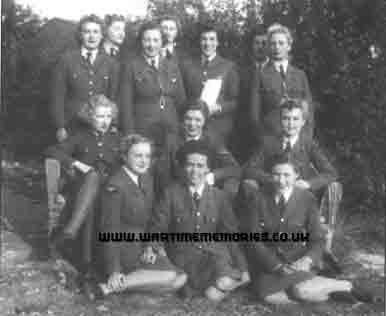 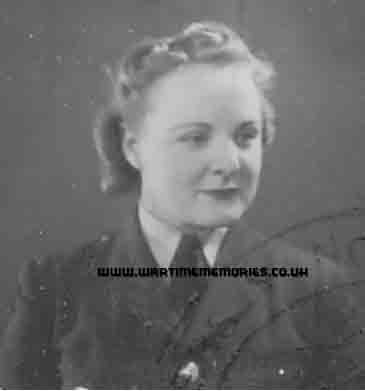 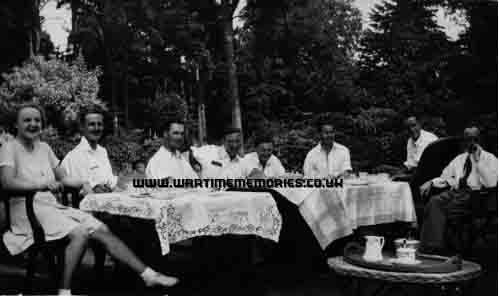 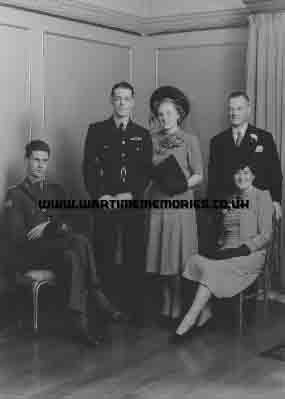 Paddy Leonard, AC2, WAAF, as everyone knew her at RAF Biggin Hill during the Battle of Britain, was a member of the "Glamour Watch." A plotter working in the Ops Building as part of a skeleton crew, she had volunteered for the work duty the day that a 500-lb bomb came through the roof, bounced off a safe and blew up in the back room where it was redirected. Somewhat protected by the heavy plotting table under which she dove, she was not injured by the flying glass, metal and wood shards that resulted from the explosion. With the crackling of a fire heard behind them, the staff in the Ops Building quickly exited the room through the blown out windows. Because of the events of that day, two non-commissioned officers in the building later received the Military Medal. As tradition has it it was most likely also presented to them on behalf of the crew on watch that day.
Paddy Leonard spent a year at RAF Biggin Hill through the period that made the station famous. Part of that time was spent in the old vacated butcher's shop in the Pantiles, which was a temporary new home to the Ops Room plotters until other more permanent facilities could be arranged. Picked up by lorry, the WAAF personel were transported daily to and from the shop which they entered from the rear to avoid any attention to their presence there.
As the need for WAAF officers grew with the ever expanding war, the early veterans of RAF Biggin Hill rose to fill those rolls. Personally selecteed by Assistant Section Officer Felicity Hanbury who would eventually become the head of the WAAF during WWII, Paddy Leonard's next claim to fame was becoming the first WAAF officer, (in fact, the first WAAF) and cipher officer at RAF Wigtown in Scotland, No.1 Air Observer School. Within 2-1/2 years Paddy Leonard grew from an art student at the Croydon School of Art to the rank of Section Officer in the WAAF, senior officer to a 250-WAAF contingent at RAF Wigtown. She also logged 60 hours of flying time as a passenger of various aircraft arriving at of flying out of the station, a requirement of all officers according to her CO so they would know what the flyers had to endure, even though it was against regulations for WAAF to fly early in the war. When she resigned her commission she was only 22 but a seasoned veteran of WWII. Married to a Canadian pilot in the RAF in 1942 she left the WAAF in November 1942 after more than 2-1/2 years of service as she was expecting the first of her four children. Two were born in Harrogate England during the war where she went to join her husband after he was reposted and two others were born in Montreal, Canada after the war.
Paddy Leonard, or Pat Carswell, as eveyone came to know her after her marriage, lived on the Island of Montreal from 1945 to 1974 when her husband took early retirement from his corporate executive job and they moved to the Rideau Lakes area about 25 miles north of Kingston, Ontario. In more than 30 years of retirement she and her husband enjoyed living by the lake, numerous trips, camping, international travel, visiting Scotland and England and touring Europe with their daughter and son-in-law who had settled in the Netherlands where he grew up.
Born in London on February 23rd, 1920 within the sound of Beau Bells, she was the granddaughter of a Irish blood but English-born London Dock Worker who she never knew and a Swedish-Finnish carpenter who learned his trade at sea. They both married English girls in London. As a switch from her ancestral background she was the daughter of a James Leonard who rose to become a member of the London Stock Exchange. She came from a very unusual background. But like her father who had served in WWI she felt it was her duty to serve in WWII. She believed that had her father had any sons, they would have done the same as did a number of her second cousins who were pilots in the RAF. She lived a happy life dying peacefully at the age of 85 on September 12th, 2005 in her home by the lake less than a month after returning from an Alaskan Cruise. She live life to the fullest and enjoyed every minute of it. May she rest in peace.
|
William Smith 72 Squadron I am the Grand Daughter of William Smith (Bill), and I have been learning the stories today of his time in service in the RAF WW2, Squadron flying Spitfires from Biggin Hill. I have heard some totally mind blowing events, and I am so proud of my Granddad! I feel now, I have to try and do something for him... He has just recently lost his wife, and I would love him to know we all care, and honour him as a person/ Granddad, and a war hero, as many of you are. I would love to find out if there are any events, I could bring my Granddad to in relation to the Spitfires, or 72 Squadron of Biggin Hill. He has not managed to attend such things in the past, but I will make sure we get him there now. His ultimate dream would be to go up in a Spitfire! I have been reading that there is only 3/4 two seaters in the uk, but they are not licensed to carry paying passengers. Would anyone be able to let me know if there is any possibility that a old servent of the RAF, would be able to attend a display, or get a flight in one of these planes. I am so desperate to spark his spirit again, I would appreciate any information on where to bring him for a reunion, or see Spitfires flying again.
|
Flt. Offr W. Wylton Todd Biggin Hill & Little Snoring 29th and 169th Sq My mother is the daughter of W. Wylton Todd. Wylton was an RAF navigator who designed the memorial for the fallen 50 officers who were shot after the Great Escape. It still stands in Zagan, Poland.
He was assigned to the North camp after being shot down in a Mosquito on Feb 15, 1944. The pilot was the famous Commander "Jumbo" Gracie, who unfortunately went down with the plane in Hannover. Cmdr. Gracie was an older, decorated pilot who was instrumental in organizing flight standards for pilots in Malta and North Africa. Wylton was older too, but lied about his age so that he could join the war effort. He was 38 by the time he was shot down.
Wylton was a piano virtuoso. He designed, wrote and produced several of the musicals during his capture (i.e., Messalina, Paulina Panic). He worked with Rupert Davies, Peter Butterworth, Talbot Rothwell and a few others. They signed his war log. I'm certain that theater kept him and many others sane.
He was not only a great musician, he was already a successful architect in London before the war. King Edward honored him with recognition at the last Levee in 1936. A remarkable distinction for the young professional.
Since he was first held in Dulag Luft, then brought to SL3, he would have arrived just before the great escape on March 25. My mother maintains that he told her that he worked on the tunnels and escape efforts. His drafting abilities and keen eye probably made him a good forger or mapmaker.
After the war, Wylton was commissioned to design a memorial at Biggin Hill, from which most of the Battle of Britain pilots tenaciously defended their country. He stayed in the UK to rebuild London.
He also designed a palace for a Maharaja in India, Redesigned The Elms in London, a mansion in Mexico and designed plans for a massive luxury complex for Arthur Vining Davis in Eleuthera, Bahamas. Unfortunately it never came to fruition because of political complications. He died shortly afterwards from a freak accident in 1961. I never met him, but have learned quite a bit about this amazing man.
I'm currently working on research about his activities in the North camp theater. If anyone knows more about him or particular info about the North camp theater I would appreciate it.
|
Stanley Andrew Farrow My grandad was at Biggin Hill 1940 to 45. His name was Stanley Andrew Farrow born 1 Aug 1912. I have no photos of my grandad in his uniform or know anything about his RAF life only what my mum and uncle have told me. He would have been 100 this year had he still been with us. I would really like to find out more.
|
Pte. Alfred Doyle Middlesex Regiment I'm attempting to write the biography of my grandfather, Alfred Doyle who served in the Middlesex Regiment during the Second World War, mainly on anti-aircraft. He served in several places, including Biggin Hill. Later he was part of the occupying amry in Germany in a place called Nurenburg.
I'm wondering if anyone has any idea how I can get his war record or a record of the regimental diary?
Editor's note: Please see our Family History FAQ's for details on how to obtain his service record, regimental war diaries are held in the National Archives.
|
Charles Appleby Charles Appleby served as Maintenance Crew at Raf Biggin Hill.
|
S. E. Chandelr Flight Sergeant S.E Chandler served as a medic at RAF Biggin Hill
|
Maurice Edward Hunt 202 Squadron 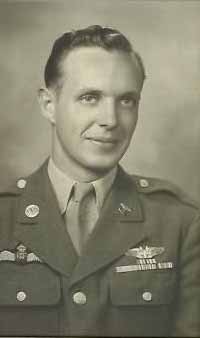 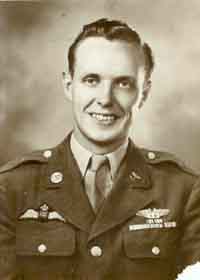 My Dad served with the RCAF, RAF and USAAF during WWII. His name was Maurice Edward Hunt. He was trained in Regina at the #15 Efts and then in York or Yorktown canada where he was awarded his wings. It depresses me to come to the conclusion that he is part of the Lost Legion. He was born October 29, 1920 in Lancaster, Washington, USA. I have no idea if he used an assumed name while in the RCAF. I think not as someone did find some personell cards in his name. He was shot down twice, flew Night Fighters and Spitfires among other aircraft. He had many ribbons which he wore on his USAF uniform but they have vanished. He was discharged from the RAF in 1943. He served as a waist gunner with the USAAF for the rest of the war. I have two photographs of him wearing an american uniform with RAF wings. Also in his air cadet uniform and two newspaper articles on about his fourth oak leaf cluster while serving as a gunner on an B-17 an another about his being shotdown. was with the 202 squadron, 11 group, Bigin Hill. Also that he trained to fly spitfires at Grangemouth, Scotland. Also this is copied from his records: 30 Dec 40 to 3 Mar 43 RCAF & RAF Service Plt Sq Leader, 122 Aerial Missions; 320 Combat Hrs. 5 En Planes shotdown.
|
F/Sgt. Frederick William Reynolds RAF Biggin Hill My father served in the RAF during WWII. He was a F/Sgt and I think he was stationed at Biggin Hill. He was the Squadron boxer.
|
LAC John "Jock" Robertson RAF Biggin Hill My grandfather John "Jock" Robertson, LAC, served at Biggin Hill.
|
Arthur "Dick" Collins 78 Squadron 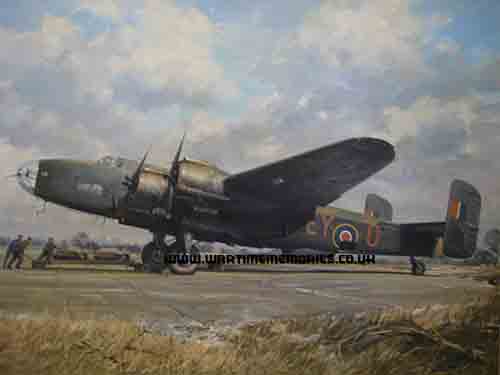 Arthur Collins was born in 1921 in Beckenham, Kent. He left his home in Knockholt Kent at 15 years old and joined the Army with the 4th Battalion Queen's Own Royal West Kent Regiment as a private and in 1938 he won the battalion's Rifle championship at only17 years of age!
By 1939 he got tired of the army, wishing to fly, so joined the RAF close to his home at RAF Biggin Hill, Kent. Originally, he was an aircraft engine fitter but was quickly recognised as suitable for aircrew training. He was sent by ship to Canada and trained as aircrew with the Royal Canadian Air Force at 31 ANS Port Albert flying Avro Ansons, transport aircraft. His flying career as a navigator started 9th of July 1942. Upon return to the UK and whilst based at RAF St Athan near Cardiff, South Wales he met Doreen Heslop, who was serving in the Women's Royal Air Force and they got married at St Sampsons Church, Grangetown, Cardiff, South Wales.
After he finished flying Ansons he transferred to Bomber Command and his first flight on bomber aircraft was on 16th June 1943 on Wellingtons with 20 OTU and the course continued through to 25th July 1943.
From 2nd until 23rd September 1943 he was with a HCU flying in Halifax bombers for the first time. He then joined 78 Squadron at RAF Breighton, Yorkshire. On 11 November 1943 he had his first flight in Halifax K.HR74
Then on he crewed 24 flights in Halifax aircraft over Germany. These included operations to:
- Leipzig on 3rd December 1943 in O-LW330,
- Frisian Islands, mine laying on 20th January 1944 in G-LW342,
- Berlin on 20th January 1944 in K-LW288,
- Berlin on 15th February 1944 in O-LV794
Finally, on the night of the 25th/26th February whilst returning to RAF Breighton from Augsburg Southern Germany his Halifax E-YO aircraft was shot down by a JU88.
Sadly, most of the crew, including the pilot were killed but Arthur was blown out of the aircraft but survived and was taken Prisoner of War being moved finally to Poland.
On 7th June of Arthur's son and two grandsons attended his former 78 Squadron reunion at RAF Breighton Yorkshire being the airfield from which he left in his Handley Page Halifax LV794 E-YO bomber for Augsburg south Germany on the 24th/25th of February 1944 which he failed to return. On that fateful final flight on 25th February 1944 returning from bombing the MAN diesel factory in Augsburg Germany his aircraft was shot at by a JU88 night fighter and the aircraft caught fire and exploded. The Luftwaffe pilot Maj. Gunther Radusch engaged the Halifax at a height of 6,500 mtrs. at 00.20 hrs. over the village of Fischbach bei Dahn, Rheinland-Pfalzer in southern Germany. At the date the aircraft went missing, Arthur had logged up 300.75 hours flying time. Arthur was blown out of the aircraft but luckily regained his senses just 300 metres before he hit the ground he pulled his parachute cord and landed in a fir tree. The rear gunner who also survived, cut him down from his parachute which was stuck in the fir tree. Arthur's leg was very badly injured with bullet holes and shrapnel and was pulled to a roadside at the edge of the village of Fischbach bei Dahn and left until a farmer picked him up in the morning.
He was taken to a convent hospital and the doctors fixed him up exceptionally well. The German pilot that shot him down came to visit him in hospital a few days later expressing his regrets at killing some of Arthur' crew and spoke in perfect English as he had spent 4 years at Oxford University in England before the war. He left Arthur a supply of cigarettes and chocolates. When he was fully recovered he was transferred to POW camp in Poland.
As injured aircrew were not sent home in World War 2 by the Germans, Arthur managed to procure a Polish corporal's uniform and escaped to Switzerland. The Swiss Red Cross managed to get him on board a hospital ship, Arundle Castle in Marseilles and he returned to the Liverpool in February 1945.
After the war in early 1946 he was initially stationed at RAF Swanton Morley Norfolk for retraing on Whitleys, then RAF Driffield Yorkshire. In early 1950 he was posted to RAF Waddington Lincolnshire flying Avro Lincolns. In 1953 he was posted to RAF Marham Norfolk flying B29 Washingtons. In 1955 he was sent for 6 months to RAAF Toowoomba Australia with the B29 on Atom bomb trials. Upon return was posted to RAF Waterbeach, Cambridge,then in 1957 to RAF Watton Norfolk followed by RAF Tangmere Chichester.
Then Arthur rejoined his wartime 78 squadron again in 1959 for 3 years at RAF Khormaksar, Aden flying Twin Pioneers. He returned to the UK at RAF Northolt with Met Comm Squadron on both Devons and Pembrokes flying VIPs including Prime Minister Harold Wilson. In 1964 he was posted to RAF Wildenrath Germany for 4 years returning back to RAF Northolt and ceased flying in 1973. He continued with the RAF at RAF Northollt with Air Traffic Control and in his final years in the RAF with Aeronautical Information Documents Unit (AIDU) until retirement at RAF Northolt in 1979.
During his 40 year career with Bomber/Strike, Transport, Met Comm squadrons he flew in 15 different types of aircraft including Ansons, Wellington, Whitleys, Halifax, Hastings, Lincolns, B29 Washington Superfort, Twin Pioneers, Pembrokes and Devons.
Shortly before his death in Dorchester Devon in August 2000 Arthur was reunited with one of his former aircraft a De havilland Devon at Compton Abbas airfield near Shaftsbury Devon which he flew in the 1960s from RAF Northolt and RAF Wildenrath Germany. It was Prince Philip's personal aircraft which His Royal Highness flew it 67 times whilst it was originally part of the Queen's Flight. His son Roger bought this aircraft in 1996 and has been restored and is still flying today. It was used as a fly past at Arthur's military funeral on Portland Dorset in August 2000. Arthur's ashes are buried in Knockholt churchyard in the village of his childhood and reunited with Doreen his wife of over 50 years.
|
Sect.Off. Monica Fenton "Nicky" Wingate 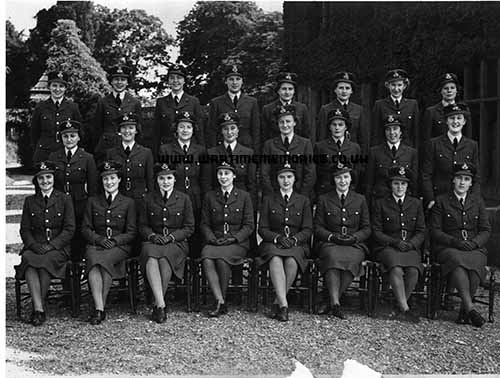 My Grandmother, Monica Wingate, joined the WAAF on 8th September 1939 as an ACW 2 (Aircraftswoman 2) at RAF Halton, Buckinghamshire for initial training and trade training as a plotter.
21st January 1940 posted to Leighton Buzzard, Beds for further training as a plotter.
On the 27th of January 1940 she was posted to RAF Biggin Hill, Kent. Promoted to ACW 1 on 1st May 1940 and Acting Corporal on 1st October 1940.
On the 19th of November she was posted to RAF St Eval, Cornwall.
From the 25th May 1941 to 21st June 1941 she attended Course No.79 at Oxford. This course tested suitability for Code and Cypher work and as she was successful my Grandmother was awarded a Commission. What type of work she was to undertake is not clear at present.
On the 20th June 1941 Commissioned as an Assistant Section Officer (Service No. 2157).
From 23rd June 1941 to 28th June 1941she was at No.1 WAAF's Depot and attended a course at Gerards Cross, London as to how to keep WAAF`s in order. All of my Grandmother`s duties from now on were in Code & Cypher work.
29th June 1941 she joined HQ 14 Group.
On the 22nd July 1941 she was posted to RAF Peterhead in North East Scotland, aFighter Station. Monica was one of the first residents there.
On 5th January 1942 she moved to RAF Tain near Thurso, a Fighter Station, she was Appointed Section Officer on 21st of June 1942.
On 25th October 1942 she moved to RAF Hurn near Bournemouth, Hants.
and on 5th June 1943 was posted to RAF Hurn and transferred to 38 Group Airborne Forces. Activities of 38 Group were towing of gliders and dropping of parachutists.
From 3rd November 1943 to 14th November 1943 she was detached on course to W.O.S Windemere in the Lake District. Then on 25th November 1943 she moved to RAF Ringway near Manchester, 38 Group. No.1 Parachutists School.
On the 21st of February 1945 she moved to RAF Rivenhall near Witham in Essex with 38 Group. Here she met my Grandfather, Squadron Leader William Henry Edwards DFC.
On the 17th May 1945 they were married in St Nicholas Church in Witham, Essex.
On 14th October 1945 she resigned her Commission and left WAAF Service.
It is still unclear what my Grandmother's duties were in Code and Cypher. On the few occasions she spoke about her war service she expressed that they were some of the best times of her life. Many friends were made, lost and extremely difficult times were had. My Grandmother always said that if she had her time all over again and had option to delete her war service, she most definitely would not and is rightly proud of her achievements.
|
Sgt. Elva Joan Blacker Elva Blacker, whose service duties were in motor transport, was an artist and sketched or painted over 1000 air and ground crew at RAF Biggin Hill. Her work is owned by the RAF Museum and includes paintings of many ace pilots.
|
Recomended Reading.Available at discounted prices.
|
|
|














